mobile View, to the German Version tap the flag


- Guernsey, with the neighbouring islands of Alderney Herm, Sark and Jethou, constitutes the administrative bailiwick/district of Guernsey, an autonomous and by the British crown-adminstrated territory
- one of the Channel Islands (Norman Islands)
- own name in French: Guernesey
• Flags
• Historical Flag
• Meaning/Origin of the Flag
• Coat of Arms
• Meaning/Origin of the Coat of Arms
• Maps
• Numbers and Facts
• History
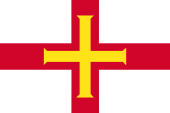
since 1985,
Flag of Guernsey (National flag),
ratio = 2:3,
Source, by:
Wikipedia (EN),
World Statesmen





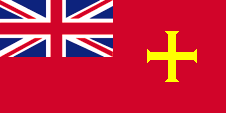
since 1985,
Merchant flag,
ratio = 1:2,
Source, by:
Wikipedia (EN),
World Statesmen



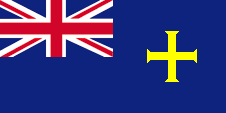
since 2000,
Flag of the government (state flag),
ratio = 1:2,
Source, by:
Wikipedia (EN),
World Statesmen



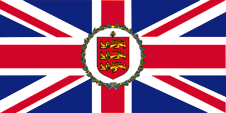
Flag of the Lieutenant Governor,
ratio = 1:2,
Source, by:
Wikipedia (EN)




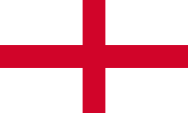
1936–1985,
Flag of Guernsey (National flag),
ratio = 3:5,
Source, by:
Wikipedia (EN),
World Statesmen






Guernsey uses the flag of England, the red St. George's cross on white background with a golden cross, the symbol of the island, overlaid on the red cross. The cross is also in use since 1985 in the flying end of a Red Ensign, so the merchant flag, in English better known as Civil Ensign and since 2000 even in a Blue Ensign, the flag of the government (state flag). With this Guernsey follows the British ensign-system. This and the use of the "Union Jack" points to the connexions to United Kingdom. United Kingdom introduced a flag system in 1864 in which:
• war ships fly the "White Ensign" (naval flag), a white flag often with an uninterrupted red St. George's-Cross and with the Union Jack in the upper staff quadrant of the flag,
• merchant ships fly a "Red Ensign" (also named "Civil Ensign" => civil flag, the real merchant flag), a red flag with the Union Jack in the upper staff quadrant of the flag, and
• governmental ships fly the "Blue Ensign" (flag for the use by the gouvernment => the actual state flag), a blue flag with the Union Jack in the upper staff quadrant of the flag.
Since 1865, ships of regional or colonial governments, as well of offices and authorities, were allowed to use a Blue Ensign with a badge in the flying end. Merchant ships and seafaring persons from colonies were only permitted to use the Red Ensign with a badge, then also named Civil Ensign, if permission has been given to the respective colony by the British admiralty.
Source:
Wikipedia (EN),
World Statesmen,
Die Welt der Flaggen,
Volker Preuß


Coat of arms of Guernsey,
Source, by:
Wikipedia (DE)

The coat of arms of Guernsey shows the heraldry of England, lurpassed by a small golden leaf branch.
Source: Wikipedia (DE)

Location:
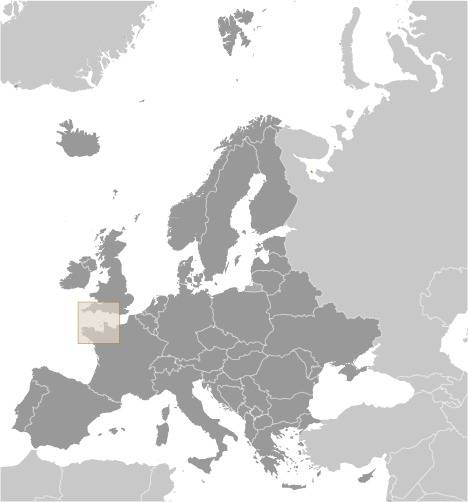
Source: CIA World Factbook
Map of the country:
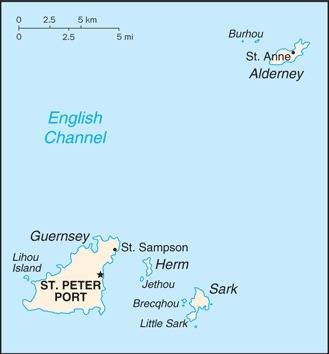
Source: CIA World Factbook
Map of the Channel Islands:
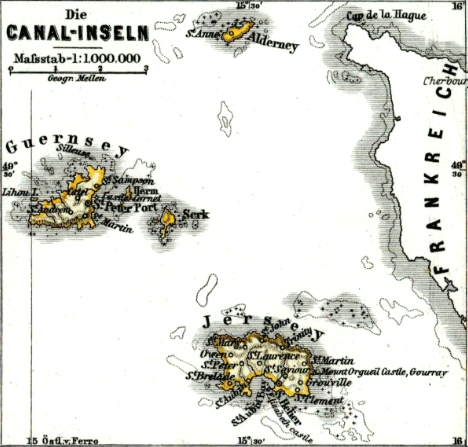
Source: Hand-Atlas für die Geschichte des Mittelalters und die neueren Zeit, von Spruner und Menke
In the north Alderney, in the south Jersey, in the west Guernsey, eastern of it Herm and Sark.

Area: 30 square miles
Inhabitants: 62.307 (2018)
Density of Population: 2.069 inh./sq.mi.
Capital: Saint Peter Port (franz.: Saint Pierre), 18.798 inh. (2016)
official Languages: English, French
other Languages: Norman French
Currencies: 1 Guernsey Pound (£) = 100 Pence, 1 Pound Sterling (£) = 100 Pence
Time Zone: Greenwich Meantime = CET – 1 h
Source:
Wikipedia (DE)

ca. 600 B.C. · Celtic settlement
56 B.C. · to the Roman Empire
511 · to the Frankish Empire
843 · to the West Frankish Empire
880 · to the Kingdom of France
933 · to the Duchy of Normandy
1066 · William I. (Duke of the Normandy) gets crowned to the King of England, therewith come the Channel Islands nominally to the English crown
1106 · King Henry I. of England (son of William I.) occupies the Channel Islands, separates them therewith from the Duchy of Normandy, and binds them on England
1940–1945 · occupied by the German Empire
Translator of the English text: Joachim Nuthack
Source:
Atlas zur Geschichte,
Wikipedia (DE),
Discovery '97


![]()






















